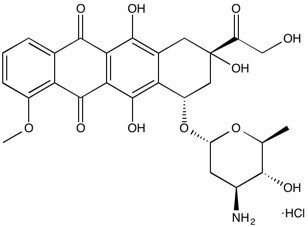Epirubicin HCl | DNA damaging agent
NMR (Conforms)

Available Options
| Size : | Price | Quantity | |
|---|---|---|---|
| 5 mg | $48.00 | ||
| 25 mg | $190.00 |
Epirubicin HCl (56390-09-1) is an antitumor agent.1 Inhibits topoisomerase II.2 Induces DNA damage by a number of different mechanisms including intercalation, free radical-mediated oxidation, crosslinking, interference with DNA unwinding, strand separation and helicase activity.3 Epirubicin HCl induces myocardial dysfunction as a side effect to chemotherapy.4
References/Citations:
1) Cersosimo et al. (1986), Epirubicin: a review of the pharmacology, clinical activity, and adverse effects of an adriamycin analogue; J. Clin. Oncol., 4 425
2) Spadari et al. (1986), DNA polymerases and DNA topoisomerases as targets for the development of anticancer drugs; Anticancer Res., 6 935
3) Minotti et al. (2004), Anthracyclines: molecular advances and pharmacologic developments in antitumor activity and cardiotoxicity; Pharmacol. Rev., 56 185
4) Mercuro et al. (2007), Early epirubicin-induced myocardial dysfunction revealed by serial tissue Doppler echocardiography: correlation with inflammatory and oxidative stress markers; Oncologist, 12 1124
NMR (Conforms)
Safety Data Sheet:
Product Data Sheet:
Materials provided by Focus Biomolecules are for laboratory research use only and are not intended for human or veterinary applications. Please note that we do not sell to individuals and that all orders placed by non-research organizations will incur a $20 restocking/refund fee
Epirubicin HCl (56390-09-1) is an antitumor agent.1 Inhibits topoisomerase II.2 Induces DNA damage by a number of different mechanisms including intercalation, free radical-mediated oxidation, crosslinking, interference with DNA unwinding, strand separation and helicase activity.3 Epirubicin HCl induces myocardial dysfunction as a side effect to chemotherapy.4
References/Citations:
1) Cersosimo et al. (1986), Epirubicin: a review of the pharmacology, clinical activity, and adverse effects of an adriamycin analogue; J. Clin. Oncol., 4 425
2) Spadari et al. (1986), DNA polymerases and DNA topoisomerases as targets for the development of anticancer drugs; Anticancer Res., 6 935
3) Minotti et al. (2004), Anthracyclines: molecular advances and pharmacologic developments in antitumor activity and cardiotoxicity; Pharmacol. Rev., 56 185
4) Mercuro et al. (2007), Early epirubicin-induced myocardial dysfunction revealed by serial tissue Doppler echocardiography: correlation with inflammatory and oxidative stress markers; Oncologist, 12 1124
Calculate the molar concentration, mass or volume in a solution.
Concentration × Volume × Molecular Weight = Mass
Focus Biomolecules • Plymouth Meeting, PA USA • 1-855-FOCUS21
Focus Biomolecules
Plymouth Meeting, PA USA
1-855-FOCUS21
Website Created by Advanta Advertising LLC.

